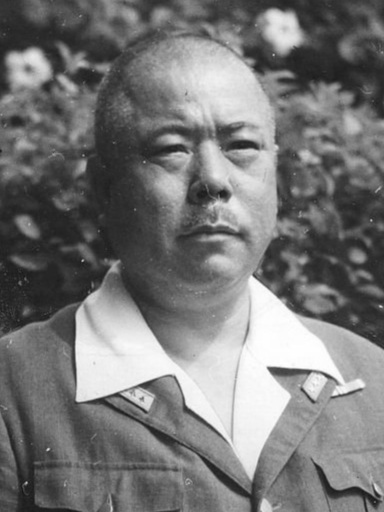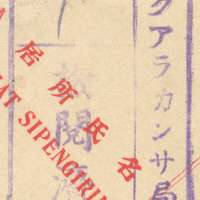STAMP PHILATELY
Malaya Japanese Occupation - 4¢ Postal Stationery 1943 (Written in Jawi)
GENERAL INFORMATION
State
Japanese Military Occupation
Country
Malaya
Type
Postcard
Class
Postal Stationery
Front Inscription
大日本帝国郵便 ♦ マライ ♦ 4 セント ♦ 郵便はがき ♦ 差出人居所氏名 Nama dan Alamat Sipengirim ♦ 名宛 Alamat
Face Value
4 cent
Issued Date
29/04/1943
Postmark
30/08/1943
Postmark Town
Kuala Kangsar
Gum
No Gum
Dimension
141 × 92 mm
IN COLLECTION CONDITION
Preliminary
Normal
Condition
Used With Postmark - Fine
CATALOG INFORMATION
GP-4
Standard Catalog of Malaysia, Singapore & Brunei
Malaya Japanese Occupation - 4¢ Postal Stationery 1943 (Written in Jawi)
Japanese Occupation of Malaya

The Japanese invasion on Malaya after midnight of 8 December 1941 under the order of Lt Gen Tomoyuki Yamashita was considered the first day of Japanese Occupation.
Japan surrendered to the Allied Powers at noon on 15 August 1945. Malaya and Singapore returned to British colonial rule on 12 September 1945 with the formal surrender by the commander of Japanese forces in South East Asia, when Gen Seishiro Itagaki surrender to Lt. Louis Mountbatten at Singapore City Hall.
Postal Stationery
A 4 cents postcard was issued on 29 April 1943. The indicia was the same design as the 4 cents stamp, the wording is also in red. Most of the cards are on quite flimsy light-weight card, which is watermarked Government Printing Works Singapore. The watermark extends across several cards, so a card may have part of it or a straight line or no visible watermark. The watermark tells us where the card came from, and probably where the postcards were printed. A vast number of these cards were printed and used postally. They were cheap, available and postal censorship by the Japanese was tough and continued throughout the occupation.
Postcard, Addresses, Postmark & Cachet
The sender's address:
Line 1: PM 4
Line 2: 8 30
Line 3: 2603
30/08/1943 : Monday
Indicia
At top: 大日本帝国郵便 - Imperial Japanese Posts
At bottom middle: マライ - Malaya
At bottom left: 4 セント - 4 Cents
Cencor chop (cachet):
At right: クアラカンサ局 - Kuala Kangsar Office
At left: 検閲済 - Censored
Postcard
The heading on the card reads
郵便はがき
English: Postcard
Malay: Poskad
The Japanese and Malay at upper right are
名宛
Malay: Alamat
English: Address
The Japanese and Malay at upper left are
差出人居所氏名
Malay: Nama dan Alamat Sipengirim
English: Name and address of sender
Jawi Script
Jawi script is a writing system that borrowed Arabic alphabet and adding a few more to complement the Malay sounds that don't exist in Arabic language. It is written from right to left. The pronunciation of the script is the same as if it is written in Roman script. It is an alternate writing system in Malaysia, but it was very common among the people of Malaya as it is the only writing system taught at the school and Roman script only taught at English-based schools in big towns. It was a dominant script for the royal, official and reading materials. It was later when Malaya gained independence, the Roman script took superior place and only accustomed to religious and official matters.
Introduction
The postcard was sent by Muhamad to his elder brother Abdullah.
Notes:
1. Assumption: the writer went to English school as Roman script writing were limitedly used and taught. Only privilege few of Malays have the chance, OR it was two different person who wrote the addresses and the text on the back.
2. The writer might still survive? Or else try to find the surviving family.
3. Japanese characters and translations were provided by tonymacg, which I am very grateful.
4. The Jawi transcribing were the work of Halim and some part were of Zuraidah Zandar and Abdul Rahim Jusoh.
5. As the process of transcribing has yet to be finished due to some unreadable parts, this project will be kept opened. Anyone with suggestions or more information or any input is welcome to write to me at msah83@gmail.com
6. Process for transliteration will started and updated very soon.
7. A personal thank you to Thomas Slemons for helping me updating the correct date and information related to the processing time of the postmark. (16/05/2013)

The Japanese invasion on Malaya after midnight of 8 December 1941 under the order of Lt Gen Tomoyuki Yamashita was considered the first day of Japanese Occupation.
Japan surrendered to the Allied Powers at noon on 15 August 1945. Malaya and Singapore returned to British colonial rule on 12 September 1945 with the formal surrender by the commander of Japanese forces in South East Asia, when Gen Seishiro Itagaki surrender to Lt. Louis Mountbatten at Singapore City Hall.
Postal Stationery
A 4 cents postcard was issued on 29 April 1943. The indicia was the same design as the 4 cents stamp, the wording is also in red. Most of the cards are on quite flimsy light-weight card, which is watermarked Government Printing Works Singapore. The watermark extends across several cards, so a card may have part of it or a straight line or no visible watermark. The watermark tells us where the card came from, and probably where the postcards were printed. A vast number of these cards were printed and used postally. They were cheap, available and postal censorship by the Japanese was tough and continued throughout the occupation.
Postcard, Addresses, Postmark & Cachet
The sender's address:
The recipient's address:Muhamad bin Othman
Sayong Tebing
K. Kangsar
Perak
It was franked with KUALA KANGSAR in a circle and interior text on 3 lines, that can safely be deduced that it was processed on 30 August 19xx?Abdullah bin Chu Othman
Clerk P.W.D.
Upper Perak
(Grik)
Line 1: PM 4
Line 2: 8 30
Line 3: 2603
30/08/1943 : Monday
Indicia
At top: 大日本帝国郵便 - Imperial Japanese Posts
At bottom middle: マライ - Malaya
At bottom left: 4 セント - 4 Cents
Cencor chop (cachet):
At right: クアラカンサ局 - Kuala Kangsar Office
At left: 検閲済 - Censored
Postcard
The heading on the card reads
郵便はがき
English: Postcard
Malay: Poskad
The Japanese and Malay at upper right are
名宛
Malay: Alamat
English: Address
The Japanese and Malay at upper left are
差出人居所氏名
Malay: Nama dan Alamat Sipengirim
English: Name and address of sender
- The postcard size is 141 x 92 mm.
- Vertical crease is visible on the front.
- Four pin holes, middle-top with two holes are very clear.
- The text was written with pencil.
- The addressed were written with pencil as well.
- On the reverse, top-right, evidently was rubber-erased.
Jawi Script
Jawi script is a writing system that borrowed Arabic alphabet and adding a few more to complement the Malay sounds that don't exist in Arabic language. It is written from right to left. The pronunciation of the script is the same as if it is written in Roman script. It is an alternate writing system in Malaysia, but it was very common among the people of Malaya as it is the only writing system taught at the school and Roman script only taught at English-based schools in big towns. It was a dominant script for the royal, official and reading materials. It was later when Malaya gained independence, the Roman script took superior place and only accustomed to religious and official matters.
Introduction
The postcard was sent by Muhamad to his elder brother Abdullah.
| 1 | كهدڤن كاكندا يڠمليا عبدالله .... ماس اين د دالم |
| Ke hadapan kakanda yang mulia Abdullah …. masa ini di dalam |
|
| 2 | .دڠن بروليه سلامت دان كسجهترأنڽ .... |
| [RUBBER ERASED]…… dengan beroleh selamat dan kesejahteraan-Nya. |
|
| 3 | معلومكن ساڠتله دوكچيتا اديندا دان بوندا .... |
| …. maklumkan sangatlah dukacita adinda dan bonda |
|
| 4 | انقندا زبيدي تله تركنا ڤڽاكيت دمم كورا ڤد وقتو مالم اي مڠلتر دان |
| Anakanda Zabidi diri telah terkena penyakit demam kura pada waktu malam ia mengeletar dan |
|
| 5 | ماكن ڤون تيدق ماهو بادنڽ تركوروس سديكيت برت ڤوچت دان |
| makan pun tidak mahu badannya terkurus sedikit berat pucat dan |
|
| 6 | .... ﴾چيريت ڤولا لاڬي يڠايهندا دان بوندا سنتياس داتڠ كاتس ﴿؟ |
| cirit pula lagi yang ayahanda dan bonda sentiasa datang ke atas …. |
|
| 7 | لأوق ايكن بوجت ﴿؟﴾ جك كالو2 ماهو اي باڬي ناسي انقندا هزيزي ڤون |
| lauk ikan bojat (?) juga kalu2 mahu ia bagi nasi anakanda Hazizi pun |
|
| 8 | تيدق براڤ صيحت جوڬ دري ايت برتمبه٢ چينتا ايهندا دان بوندا اكن |
| tidak berapa sihat juga dari itu bertambah2 cinta ayahanda dan bonda akan |
|
| 9 | ايت تيدق اڤ هندق داوبتكن انقناد هزيزي اد جوڬ بوندا .... |
| .... itu tidak apa hendak diubatkan anakanada Hazizi ada juga bonda |
|
| 10 | مڠوبتڽ اڬر .... برهنتي سكجڤ كمودين كمودين باليق ساكيت اديندا هندق |
| mengubatnya agar .... berhenti sekejap kemudian kemudian balik sakit adinda hendak |
|
| 11 | ممباوا كرومه ساكيت ڤون ماسيه كڤوتوسن واڠ دهارڤكن كاكندا باليق بيسوق |
| membawa ke rumah sakit pun masih keputusan wang diharapkan kakanda balik besok |
|
| 12 | له بوليه باوا مينتا ﴿؟﴾ اوبت د رومه ساكيت. ايهندا دان بوندا ماس اين |
| lah boleh bawa minta (?) ubat di rumah sakit. Ayahanda dan bonda masa ini |
|
| 13 | سداڠ منانم ڤادي دبندڠ ڤايا. تيدق دڤنجڠكن كلام |
| sedang menanam padi dibendang paya. Tidak dipanjangkan kalam |
|
| 14 | -: لاڬي اديندا سرتاكن والسلام |
| lagi adinda sertakan wassalam :- |
|
| 15 | يڠبنر |
| Yang benar |
|
| 16 | محمد |
| Muhamad |
Notes:
1. Assumption: the writer went to English school as Roman script writing were limitedly used and taught. Only privilege few of Malays have the chance, OR it was two different person who wrote the addresses and the text on the back.
2. The writer might still survive? Or else try to find the surviving family.
3. Japanese characters and translations were provided by tonymacg, which I am very grateful.
4. The Jawi transcribing were the work of Halim and some part were of Zuraidah Zandar and Abdul Rahim Jusoh.
5. As the process of transcribing has yet to be finished due to some unreadable parts, this project will be kept opened. Anyone with suggestions or more information or any input is welcome to write to me at msah83@gmail.com
6. Process for transliteration will started and updated very soon.
7. A personal thank you to Thomas Slemons for helping me updating the correct date and information related to the processing time of the postmark. (16/05/2013)
COMMENTS
NEW COMMENT
|
The following text must accompany any text or photo taken from this page and limited use for non-commercial purposes only.
Texts and Images were taken from and courtesy of Exonumi.com
URL: http://www.exonumi.com/publish-SP.1.57
|
|





